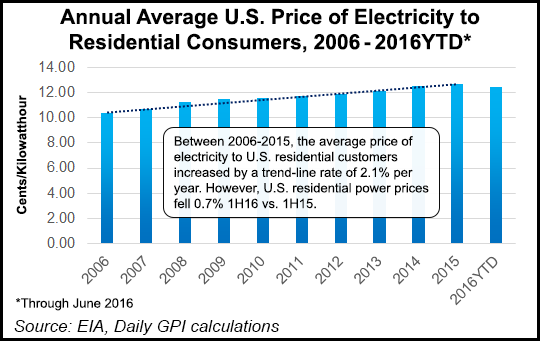Residential Customers Seeing Lower Electric Bills Thanks to NatGas, EIA Says
Besides helping to lower carbon emissions, the continued growth of cheap natural gas-fired power generation in the United States in 2016 seems to be lowering residential electric bills as well.

Based on data collected through the first half of 2016, U.S. residential electricity prices are trending down for the first time in over a decade, according to the Energy Information Administration’s (EIA) “Today in Energy” note published Thursday.
Through six months “residential customers paid on average 12.4 cents/kWh, or 0.7% lower than the same period last year,” EIA wrote. “If this trend continues for the rest of 2016, annual average residential electricity prices would decline for the first time since 2002. Over the past five years, nominal residential prices have increased an average of 1.9% annually, about the same rate as overall inflation.”
Residential ratepayers “in most areas of the country are seeing lower retail electricity prices this year compared with the same time last year,” and the availability of cheap natural gas has been one of the main catalysts, EIA said. “Over the first six months of 2016, the weighted average cost of natural gas delivered to electricity generators was $2.58/MMBtu, 28% lower than the first half of 2015.”
The New England region, coming off higher retail and wholesale power prices between 2013 and 2014, has seen residential prices fall by 6% through the first six months of 2016, averaging around 19.2 cents/kWh, EIA said. “Improved supplies of natural gas into the region, along with lower natural gas prices, have contributed to the region’s declining retail electricity rates so far in 2016.”
Noting a recent uptick in natural gas prices, EIA said its latest projections expect the average delivered cost of natural gas to be 27% higher in 2H2016 compared to 1H2016, with prices continuing to trend upward in 2017. Consequently, U.S. residential electricity prices are also expected to increase in 2017 by 3%, EIA said.
“Not all recent declines in electricity prices can be attributed to developments in natural gas markets,” EIA said. Hawaii, for example, uses petroleum in a number of its generating units, “and the falling cost of crude oil has contributed to a 12% decline in retail electricity prices so far in 2016.”
After natural gas overtook coal’s monthly share of U.S. electric generation for the first time in decades in 2015, power sector demand for gas has continued to increase in 2016 (see Daily GPI, Sept. 2).
The increased role of gas in the power stack has helped drive down greenhouse gas emissions, with U.S. carbon dioxide emissions falling below 2005 levels last year (see Daily GPI, May 9).
Even President Obama on Monday defended the role natural gas and unconventional shale development have played in addressing climate change (see Daily GPI, Oct. 4).
© 2024 Natural Gas Intelligence. All rights reserved.
ISSN © 1532-1231 | ISSN © 2577-9877 |
